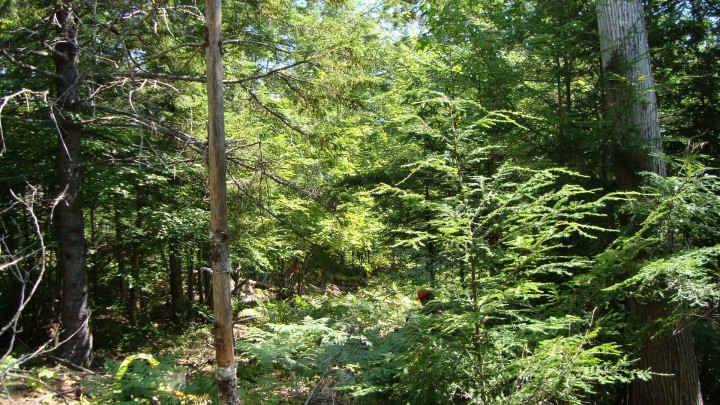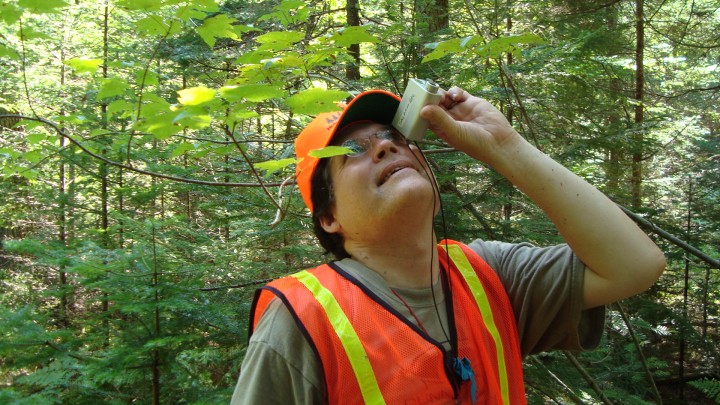Penobscot Experimental Forest, Bradley ME
Temperature: 89 ° F Humidity: 73% Wind: Calm Hazy, hot and humid
From Dr. Jon Ranson: Greetings from Maine! The North Woods are fabulous as always and I’m excited to be here again. I’ve been coming to Maine for field work since 1989 so when I see these forests, it’s a little bit like coming back to a second home.
Today was orientation day. We took time to meet each other, learn about the sites, and refresh our measuring skills. It was great to reconnect with old friends and to meet the new faces in this crowd. And we do have a little bit of a crowd here. About twenty six folks, give or take a few, will be with us during the next two weeks. Some will stay only a few days, but many will be here the whole two weeks.

This is a really diverse group. Some of us have had a long career already such as Guoqing Sun, Sassan Saatchi and myself. Some, like our graduate students, are just starting out. It’s a truly dynamic mix of talent.
This morning we starated at the University of Maine. We were briefed on the two research sites, refreshed techniques, learned about safety issues and discussed logistics. It’s been decided that we will split in two parts. Dr. Sassan Saatchi of the NASA Jet Propulsion Laboratory will lead the team measurements in the Howland forest and I’ll lead a team in the Penobscot Experimental Forest.
The safety briefing was interesting. They say many of the pines around here have branches that are stiff, short and low – and at just the right height to damage eyes. We’re supposed to be extra careful, as eye pokes are fairly common and significant injuries in these woods. The other unusual risk here seems to be bears. The black bear is native here, of course. They tell me that some hunters will put food out to attract them. They say that there are a couple of these feeding sites in the Penobscot forest, and that increases the chances that bears may be around. I guess I can only hope that no one pokes their eyes while running from bears, right?
In the afternoon, we went to the Penobscot forest site. Dr. Bruce Cook, from NASA Goddard Space Flight Center, did a great job making sure everyone knew the correct methods. He guided our practice until we became really confident that we are all making accurate, precise and repeatable measurements. It’s absolutely essential that field measurements are as close to perfect as possible, since this is what will be used to validate the data we collect from the remote sensing instruments. If we don’t do a good job, our work isn’t worth much.
I figured that we’d only spend a few minutes reviewing techniques. After all, we’re all professionals here, and many of us have measured trees for decades. It turns out, however, that readings were not always in agreement. There were slight variations in some individual techniques, and that was enough to make measurements less than perfect at times. We spent some time in review and, after “calibrating” ourselves against each other, each operator became quite reliably accurate.

It was surprising, I think, to most of us to see this – but it drove home why we have to take time to practice field techniques with others, even those of us with lots of experience. It’s invaluable to calibrate your own techniques with others and against the standards from time to time, in order to insure the best possible accuracy and repeatability. This was a wonderful opportunity to achieve really strong experimental accuracy, as well as team building. We are so good to go now; we’re going to have really sound results.
We also practiced laying out the plots. Our plots are 50 meters wide by 200 meters long. That’s a whole hectare of land – 10,000 square meters. Each team goes in and actually puts ropes– bright yellow polyester ropes – down on the ground to show the limits of the plots. Then we divide each large plot into sixteen subplots, each 25 m x 25 m. We measure one subplot at a time, logging the data into a field form as we go. Our goal is to measure one large plot in each site per day. It’s a lot of work, but possible to achieve.
By the end of the day, we had measured four subplots. I’m really pleased with the quality and the accuracy of the measurements. We ended the day hot and sweaty – we’re at near record highs in these woods today – but pretty well satisfied. I’m looking forward to tomorrow, and our first full day in the woods.



